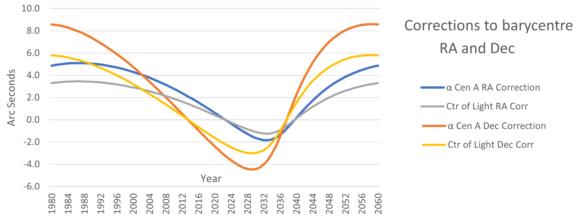
NavList:
A Community Devoted to the Preservation and Practice of Celestial Navigation and Other Methods of Traditional Wayfinding
From: Bill Ritchie
Date: 2021 Nov 28, 03:01 -0800
Frank, in your reply to Peter regarding proper motion of Rigil Kent, you stated that “there is a substantial difference between the proper motion of the individual stars and the proper motion of the center of mass." and asked “So which should we use?”
For the present time, I suggest that barycentre proper motion has become the more accurate method, whilst the individual motion method was more accurate around the time when the motion was measured.
The attached plot shows the (small) corrections to apply to the barycentre position to obtain the position of the primary component, Rigil Kent. Thank you, Robin, for the link to the Sixth Catalog of Orbits of Visual Binary Stars that enabled me to derive this information.
The Hipparcos New Reduction data quotes the proper motion of the primary, Rigil Kent (α Cen A), as -3679 in RA and 473 in declination, both in milliarcseconds per year. However the motion was measured over a three year period spanning 1991.25 and includes the orbital motion. Usimg Meeus’ Chapter 57 algorithm and the Sixth Catalog orbital data, the annual position change of Rigil Kent due to orbital motion at that date calculates as -42 mas in RA and -218 mas in Dec. which, when subtracted, gives barycentre proper motions of -3637 and 691. This is close to the Hipparcos barycentre proper motion that Peter uses of -3608 and 686.
Rigil Kent A/B have an orbital period of 80 years and the component of change in RA and Dec due to orbital motion over 80 years will be zero. So the (non linear) build up of error over each 80 year span will be 80 times the above 1991 annual orbital motion, about 3 arc seconds in RA and 17 arc seconds in Dec. Now, 30 years after the measurement, the error in dec is starting to become observable and using the barycentre position and its proper motion (even without the corrections in the attached plot) has become more accurate.
Bill Ritchie







